Appendix P. Evaluating and Selecting Hand Hygiene Products: Transcript/Facilitator Notes - Implementation Guide
Slide 1: Appendix P. Evaluating and Selecting Hand Hygiene Products
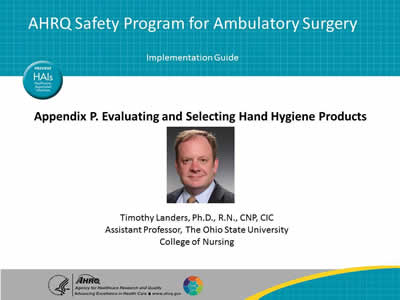
Hello, my name is Tim Landers. I'm an assistant professor at the Ohio State University College of Nursing. Thank you so much for joining us on this short webinar entitled Evaluating and Selecting Hand Hygiene Products. We're excited to share this information with you, and we hope that it will be useful.
Slide 2: Disclosures

As far as full disclosure, none of the sponsors of my current research have participated in the development or have reviewed the contents of this presentation.
Slide 3: Objectives
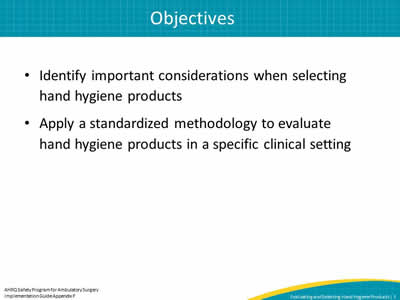
What we'd like to do today is to talk about important concepts that relate to the selection and evaluation of hand hygiene products across settings. This is particularly important, as there are key terms that we need to understand if we're going to develop an evaluation and selection protocol. In addition, there are some important new developments that are happening in terms of these criteria, so we'll discuss those briefly. Secondly, we'll present a brief method or tool that you can use to evaluate your product in using the key attributes of your local users, which is one of the elements of product selection and evaluation that's absolutely critical.
Slide 4: Multimodal Strategies for Hand Hygiene
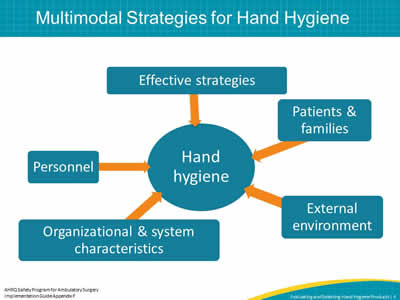
To begin, it's important to remember that comprehensive hand hygiene improvement strategies rely on a multimodal approach. These approaches are synergistic, they're coordinated, and multidisciplinary. To be fully effective, key stakeholders at the organization leadership and management levels need to be included as well as routine users. It's also important that your end users are fully committed and have very positive experiences with the program to reinforce the overall hand hygiene improvement strategy. For our purposes today, the concepts of selecting and evaluating these hand hygiene products are important from provisioning, acquisition, purchasing, and logistics, all the way down to end user characteristics and desirable attributes of these hand hygiene products. We'll just need to keep in mind that with the external environment and the strategies that most of us are already doing, including education, monitoring, feedback, that they need to be part of a coordinated strategy. And so, simply selecting the right product that's not part of this multimodal strategy is not likely to be effective, although it is one of the key elements of a successful program.
Slide 5: Understanding Hand Hygiene Product Evaluation
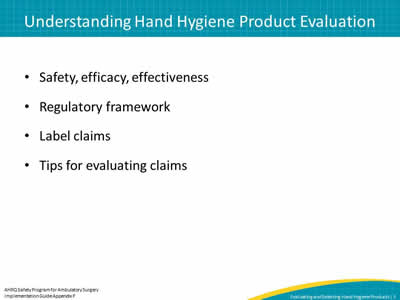
Hand hygiene products are evaluated for their safety, efficacy, and effectiveness. This regulatory framework is laid down by different governing bodies, including the Food and Drug Administration, different European agencies that regulate the contents and labeled claims that manufacturers are able to make about their products. We'll talk at the end a little bit about tips that we can use to evaluate these manufacturer claims that are presented to you and how we can objectively use the claims that the manufacturers are making in addition to the regulatory approved packaging or messaging to really help select the best products.
Slide 6: Efficacy Versus Effectiveness
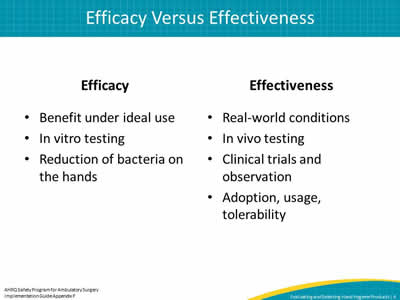
When we talk about efficacy, we're talking about the ability of hand hygiene agents to reduce the number and types of pathogens on the skin. Efficacy is tested using a highly controlled and standardized methodology. These methodologies are developed nationally and internationally, and often they occur in an in vitro setting. So, this is a controlled laboratory setting, and it may happen in a test tube or with users who are going through a very particular, specified clinical protocol to see whether the product is effective at reducing the pathogens. Effectiveness means how well the products reduce acquisition and transmission of pathogens with real-world users. We want to keep in mind this idea of efficacy and effectiveness, that even a highly efficacious agent, if it's not well tolerated by the end user, is not going to be very effective.
Slide 7: Regulatory Framework
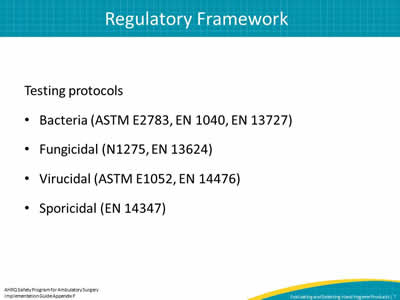
The regulatory framework includes these different technical specific testing protocols for the efficacy of these hand hygiene products, so how well do they work in the lab when an imprint is made on a Petri dish, and then the product is used and then another imprint is made. Some of the European and national standards specify the type of reagent and even the type of bacteria, viruses, fungi, or spores that are to be evaluated in the testing protocol. If you're interested in learning more about some of these testing protocols, some of them are listed here. These standardized technical testing protocols are then applied against a regulatory standard. In the United States, the tentative final monograph approves what manufacturers can say about their products if they pass these technical standards.
Slide 8: FDA-Approved Labels
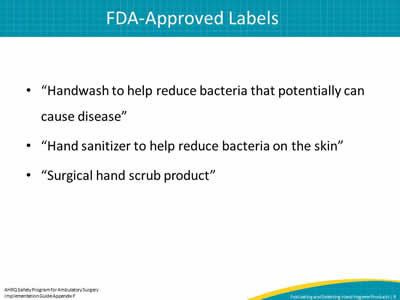
The FDA in the United States regulates what manufacturers can say their product is intended to do. One FDA-approved label claim is for hand wash products that reduce bacteria that can cause disease or hand sanitizers that reduce bacteria on the skin. Importantly, there is an FDA label indication for a surgical hand scrub product. Sometimes you'll see modifiers to these statements, such as "for use after changing a diaper," or "for professional use only." Those are additional claims that manufacturers can make that limit the intended scope of their product, where they intend it to be used.
Slide 9: Evaluating Manufacturer Claims
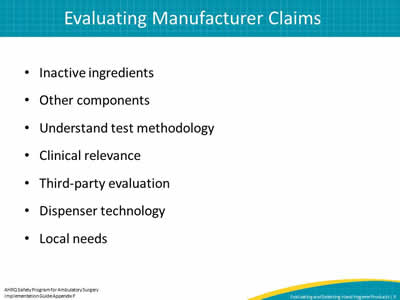
When we're looking at these manufacturer claims, we know that there are these major categories such as surgical hand scrub and that manufacturers will often bring to us additional data about the efficacy or effectiveness of their product, particularly compared to a manufacturer or an earlier iteration or recipe for their product. They do this by changing some of the inactive ingredients. Inactive ingredients are ingredients that can improve the tolerability of the skin by reducing drying or improving moisture in the skin, sometimes scents or other inactive ingredients. That's done to improve adoption and acceptability. Active ingredients in the United States, waterless hand sanitizers approved for use as surgical scrubs, contain two active ingredients or things that do the job. That's because the FDA requires for surgical hand scrubs that the active ingredients have immediate action and that also there is some persistence of effect for these surgical hand scrubs.
Other components such as aloe or different moisturizers can improve the effectiveness, the acceptability of these products, but we want to evaluate the manufacturers’ claims and see if it relates to application in our particular setting. Oftentimes manufacturers will use third-party reference labs or outside labs to test their product. That increases the validity or the confidence we have that the results are indeed correct. We also might be thinking about the manufacturer claims related to the particular product as it relates to the dispenser type and is it integrated with an ongoing system, such as a monitoring system or a novel dispensing technology that would be of particular use in your setting. This is a key point, is that it's very important to evaluate hand hygiene products for their acceptability, efficacy, and effectiveness in your local setting. It's important to do this because a wide range of factors can influence effectiveness. Not just user preferences, but things like relative humidity or seasonal variation can impact how well these products are adopted and ultimately used in your setting.
Slide 10: Action Step: Review the Labels for Products in Current Use
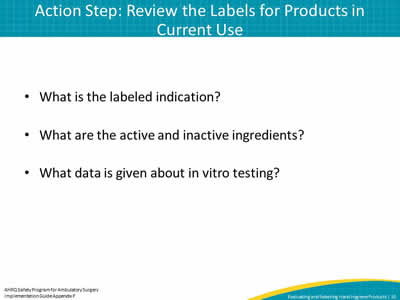
I’d like to propose an action step and challenge you to take a look at your currently used product, to look at what surgical hand washes or scrubs are used in your setting to identify the particular labeled claims and look on the label for the active and inactive ingredients. Then, as the next step, you can look for additional in vivo or in vitro data about its efficacy, effectiveness, and tolerability.
[15-second pause in audio]
Slide 11: Product Selection: Key Recommendations
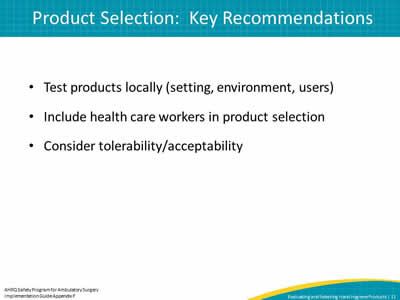
When selecting and evaluating products for your local clinical setting, it's really important that the environments and use of the setting and the user characteristics be considered. It's very important to include health care workers in product selection. We want to consider tolerability and acceptability. There are ways that we can do that. I'm going to introduce two formal methods that you can use relatively easily to evaluate different products.
Slide 12: Important Characteristics
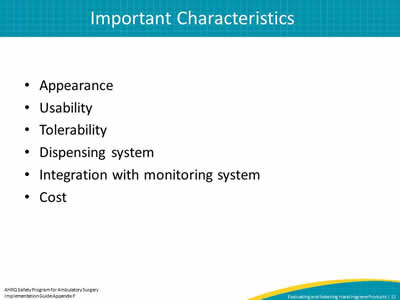
There are several main attributes that we want to be considering when we're looking at product characteristics and rating them. Things like the appearance of the product. What's the visual appearance? What's the appearance of the dispenser technology or the aesthetic, if you will? How easy is the product to use, so considering things like automatic dispensing or the amount of pressure that's required to activate a dispenser. How well are the products tolerated? Does it cause redness or itching or burning, or are some users intolerant of the added scents or residual tackiness of the products? It's important to look at the integration of the product in an overall monitoring system, so many dispenser technologies now monitor use, either onboard the dispenser or through a remotely transmitted data display of who is using the product how often and overall usage. It's also important to consider overall cost, not just acquisition cost for purchasing the product, but also what’s the potential for maintenance costs of the dispenser and monitoring system. These are all things that need to be included.
Slide 13: Product Evaluation World Health Organization (WHO) Method One
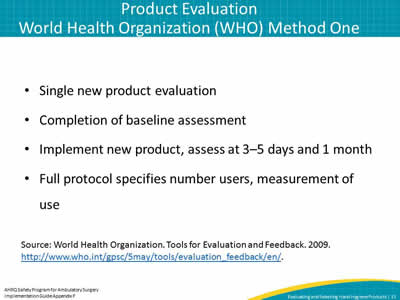
There are two main methods that I want to introduce today that have been proposed by the World Health Organization to evaluate products for hand hygiene. The first, method one, is a single product evaluation. This is a protocol where a new product is evaluated and users are asked to use only that product for a month. An assessment is done at baseline of the skin health and the perceived skin health of the user, and then after 3 to 5 days, different characteristics of the product are rated, skin health is rerated, and using the full WHO method one protocol, after 30 days skin health is reassessed and characteristics are, again, described. There are technical specifications for how many users are required and even what the acceptable user characteristics or qualities are for rating new products, according to WHO methods.
Slide 14: Product Evaluation WHO Method One
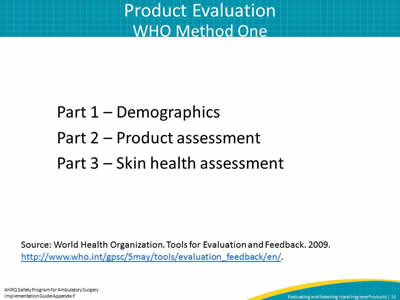
The questionnaires include things about the demographics, such as age and professional category, as well as an assessment of the product and certain features of the product as well as this self-reported skin assessment.
Slide 15: Sample Questions for Local Evaluation of Hand Hygiene Products
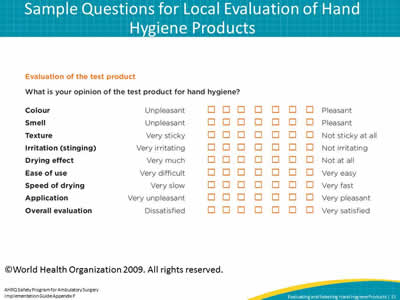
This is the table from the WHO method one protocol for evaluating hand hygiene products. In method one, after 3 to 5 days or after 1 month, users are asked to rate the product based on a variety of characteristics such as color, smell, texture, whether it causes irritation, important characteristics that many health care workers have a desire to see or an inappropriate dry time that is not too short because then they perceive that it's maybe not as efficacious, or that it's not too long, because we all know in the busy clinical setting that a product with an extreme extended prolonged dry time can be perceived as a time barrier or increased work. People are asked to rate these different products in this WHO method one evaluation.
Slide 16: Scales To Evaluate Skin Condition by the Observer
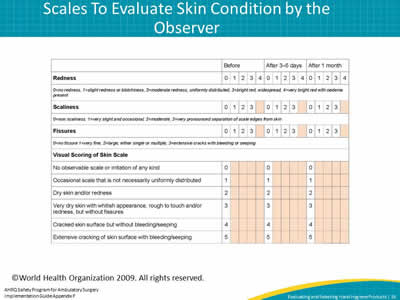
Also there is an objective skin assessment that's completed. This is completed at baseline, after 3 to 5 days, and after 30 days of using the product. This can be done by a trained observer of what is the effect of this new product on users' skin.
Slide 17: Product Evaluation WHO Method Two
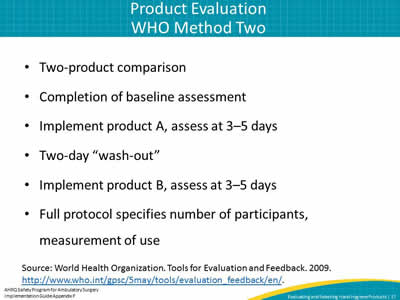
The WHO method two protocol is slightly more elaborate and it utilizes a crossover design. In this design, two products are compared. The first product is introduced and users are asked to use only that product for 3 to 5 days and then, very similar to method one, there's rating about the product characteristics and skin characteristics or skin health after that 3 to 5 days. Then there's a 2-day washout period, where they can use normal products or take a weekend off, even. Then another 3 to 5 days of a different, second product, which is also rated according to the usability characteristics and its impact on skin health. In this WHO method two protocol, there's a baseline assessment of 3- to 5-day implementation period, a 2-day washout, and another 3- to 5-day implementation period.
Slide 18: Product Evaluation WHO Method Two
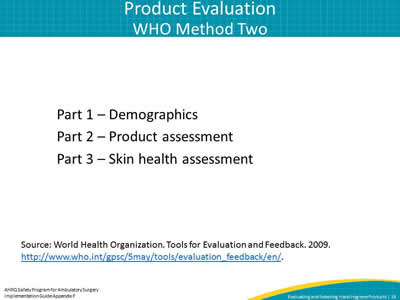
I'll give you a quick tip, which is in this WHO method two protocol. What we've done sometimes is we take the first product and after completion of both arms, we show them the first product and we show them the second product, and then we ask them, "Thank you for participating. We can leave one of these products for you. Which one would you like to keep?" We often find that that's a much more reliable indicator even than how they rank the different product characteristics of what users are looking for in an end product. That's another tip that you might try.
Slide 19: Action Step
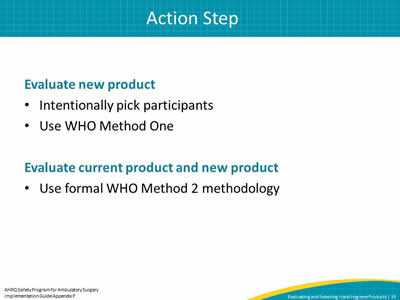
Both WHO method one and method two specify much more advanced outcome measurements including product utilization, mean scores on acceptance, but what I'd like to propose as an action step, as a challenge, is to have you just implement an evaluation of one new product. You can do this very easily by contacting a manufacturer and saying that you'd like to do a trial of a new product and just rate – use method one in a 3- to 5-day duration, and ask people to use it and evaluate it according to WHO method one. I would suggest or challenge you to pick someone in your facility who is a hand hygiene champion that you know is really interested and engaged in hand hygiene, but also pick the people who seem to be disengaged and disinterested. I think we all have plenty of examples of grumpy people who come to mind who aren't as diligent about hand hygiene. But pick them too, because they might turn around and become one of your champions and really advocate for the adoption of hand hygiene and hand hygiene improvement strategy.
If you're looking for an even greater challenge, I would challenge you to take a look at the WHO method protocol two and implement that. Take two new products that are FDA approved for your setting, implement them, and do the formal rating. You can do this with the 40 users that are specified in the WHO protocol or a number that makes sense for your program. I would suggest that this is a way to increase awareness of the importance of hand hygiene, but also really engage your frontline personnel in understanding how these products are selected.
Slide 20: Resources
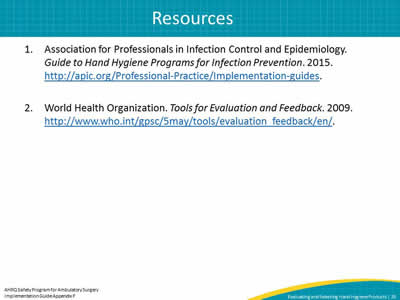
There are a couple of resources I would like to pass along. One is a Hand Hygiene Implementation Guide, published by APIC, which you can download for free at this Web address. Then the link to WHO method one and method two is available from World Health Organization Clean Hands Campaign.



